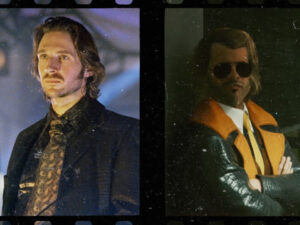Cut Scenes is Josh Wise’s regular column on the intersection between films and video games. This week, it’s Virginia vs. Eyes Wide Shut.
With Virginia, the nexus of images from the cult television and cinema of the nineties find itself pulled up from disturbed soil. Small towns, missing kids, kooky locals and kitsch diners. So often are these yellowing polaroids exhumed, and often for so lazy a purpose, that they start to resemble clues in a murder investigation: who killed our nostalgia?
But for developer Variable State, these talismans were no mere window dressing; they burnished a story of honesty and corruption, and they liquefied into a surreal stew of images. Near the end of the game, our hero, Anne Tarver, swallows a tab of LSD, inducing a chain of visions that lead her down a rabbit hole of oblique investigation. We aren’t sure of the reality of what we’re seeing, and that’s the point: it speaks to a tacit truth we feel because of our television and cinema conditioning.
The sequence above, wherein Anne envisions a cult, clad in uncanny masks and gathered around a sacrificial bull, points to the innermost emotional sensation of conspiracy and paranoia: this is the group with its hand on the levers, dressed in near moustache-twirling flamboyance, the villains of the piece. But, more important than that, what the sequence does is call into question the reality witnessed up to that point.
It is a clever conjuring of a similar scene in another cult nineties film, Stanley Kubrick’s Eyes Wide Shut. Released at the tail end of the decade, in 1999, Eyes Wide Shut tells the story of Bill Harford and his wife, Alice. Theirs is a relationship on the slide, and Bill’s perception of reality seems to be going the same way. In the scene in question, he attends an orgy carried out by a cult – they too wear unnerving masks.
What’s fascinating about the scene is the way it unscrews the lens through which we view the film’s reality, and the way that an ineffable truth – in this case the masked sexual drives lingering below the surface of Bill and Alice’s marriage – is represented on screen with Rococo relish. Prior events, too, are recast from this new, realigned perception: a series of characters Bill met on his journey to the secretive cult meeting are shown in a new light, acting strangely, remembering things differently to Bill – and to us.
Through the game’s use of cuts, Variable State manipulates the way we see Virginia, and calls into question the reality of what we see through the power of juxtaposition. Virginia’s ambiguous ending defies logic, but its emotional resolution is wholesome and sunlit. Kubrick delved into shadows to exhume the skeletons of our everyday life; he used jarring visual composition and deliberately off-kilter green screen to shake our vision of the ‘real.’ Turning on the feverish fulcrum of the masked cult scene, both film and game unravel around a point of unreality. The reason Anne takes the acid is simple: there are some truths that cannot be reached in the light and logic of day, and there are some that we’d rather stay buried.












